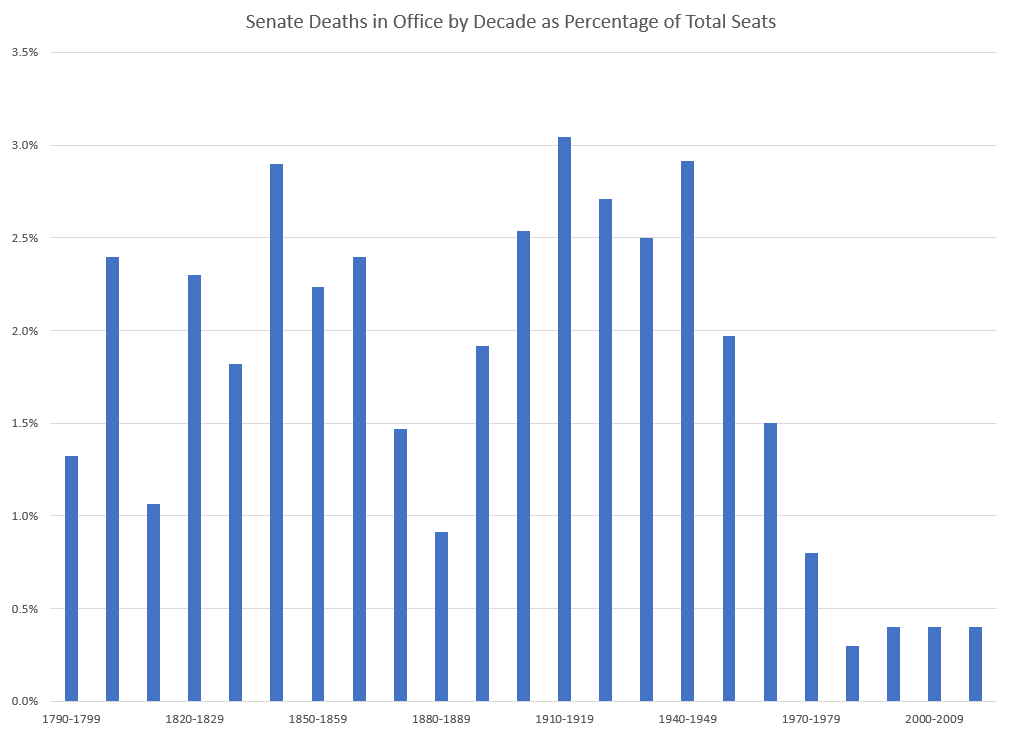Mortality with Meep: On The Congressional Body of Old Folks and Deaths in Office
(pssst, I mean the Senate)
I just got this news alert: Sen. Richard Shelby Will Not Run for Reelection in 2022
Senator Richard Shelby (R., Ala.) announced on Monday that he will not run for reelection in 2022.
Shelby is the third Republican senator to say he will not seek reelection at the end of his current term, along with Rob Portman of Ohio and Pat Toomey of Pennsylvania. At age 86, Shelby is currently in his sixth term in office and is the top Republican on the Senate Appropriations Committee.
This really should not be a news bulletin, should it?
He is 86 now. By the time of the 2022 election, he would be 88 (his birthday is in May). He would be turning 89 in 2023!
Dear Lord, you don’t have to die in office!
Senate as Old-Folks Home
First, it is entirely appropriate that there is a bunch of old people in the Senate. After all, that’s what the word literally means: group of old people.
c. 1200, “legal and administrative body of ancient Rome,” from Old French senat or Latin senatus “highest council of the state in ancient Rome,” literally “council of elders,” from senex (genitive senis) “old man, old” (from PIE root *sen- “old”). Attested from late 14c. in reference to governing bodies of free cities in Europe; of national governing bodies from 1550s; specific sense of upper house of U.S. legislature is recorded from 1775.
Okay, but sometimes it dips way too far into a gerontocracy, very literally.
I remember the spectacle of Robert Byrd of West Virginia (died age 92) and Strom Thurmond of South Carolina (died age 100) using the Senate as an old person’s home.
That those states had effectively halved Senate representation the last year(s) of these old men’s lives, well, I guess that was on West Virginia and South Carolina. They didn’t have to keep re-electing these guys.
Thurmond didn’t actually die in office, by the way — just not long after he left it.
How many U.S. Senators have died in office?
Indeed, the Senate has provided a handy list of U.S. Senators who have died in office, ever – current count is at 301.
Here is a chronological list of all U.S. Senators, and at the end we find the total number of Senators who have served is 1,994 (ah! a year! it must have a hidden meaning!)
(or not).
So the raw death rate for Senators dying in office seems to be 301/1994 = 15%
That seems really high. Let’s check out when these people all died.
Visualizing pattern of in-office deaths
Let’s grab the number of deaths per decade and take a look:
Yikes! The first half of the 20th century was unkind to senators…. or was it?
Remember that the U.S. was steadily adding states throughout the 19th century, and the addition of states slowed down considerably in the 20th century, hanging on at 48 states from 1912 – 1959.
So we really ought to normalize by the total number of Senate seats around for each period.
Here we go:
Now it does not seem the early 20th century was unduly harsh to the Senate.
Which states had the most deaths?
The next fact should tickle the interest of one of my friends who likes to keep stoopid stats (his term) about all sorts of things: with the death of John McCain, every state except Utah has had a senator die while in office.
Isn’t that exciting?
Okay, let’s take a look at a tile grid map to see which states had the most number of deaths.
Unsurprisingly, the states that have been in since the beginning have had the highest number of senatorial deaths while in office.
There are a few anomalies. Idaho, which has been a state since 1890, has had 7 U.S. senatorial deaths. What the heck, Idaho?!
Years of deaths: 1912, 1918 (January, so not the Spanish flu), 1928, 1940, 1945, 1949, 1962. Man, the 1940s were harsh on Idaho. The guy who died in 1945 was the successor to the guy who died in 1940, but the one who died in 1949 occupied the other Idaho seat.
Phew.
No cursed Idaho senatorial seat.
I think.








